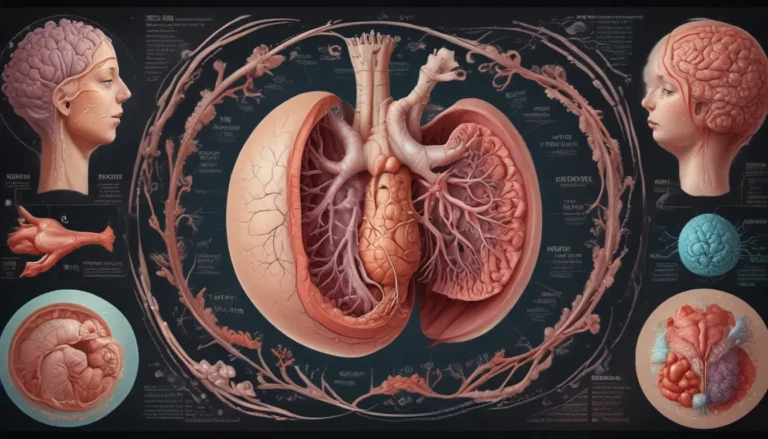A Note About Images: The images used in our articles are for illustration purposes only and may not exactly match the content. They are meant to engage readers, but the text should be relied upon for accurate information.
Embark on a captivating journey through the intricate realm of morphogens, the master architects of biological form. These remarkable signaling molecules hold the key to unlocking the mysteries of how complex organisms develop and function. Join us as we unravel 11 unbelievable facts about morphogens that showcase their profound influence on life as we know it.
The Symphony Conductors of Life
- Morphogens orchestrate the formation of tissues and organs: Like conductors of a symphony, morphogens direct cells to form intricate patterns and structures within living organisms. They follow concentration gradients and shape the body plans of diverse species, offering invaluable insights into disease mechanisms.
Unraveling the Secrets of Morphogens
1. Morphogens as Signaling Molecules
Morphogens are powerful signaling molecules that play a pivotal role in embryonic development, orchestrating the formation of tissues, organs, and body structures. They are the architects of life, guiding the intricate dance of cellular differentiation and patterning.
2. Establishing Cellular Identities
These remarkable molecules dictate the fate of cells, determining their specific functions and positions within developing organisms. By influencing cell differentiation based on their varying concentrations, morphogens sculpt the intricate tapestry of biological form.
3. Following Concentration Gradients
Operating on the principle of concentration gradients, morphogens diffuse through tissues, shaping the destiny of cells based on their concentration levels. This mechanism ensures precise spatial information is conveyed during development, leading to the formation of complex structures.
4. Origins of Morphogens
The concept of morphogens was first described by the brilliant mathematician and codebreaker Alan Turing in 1952. His groundbreaking work laid the foundation for developmental biology and revolutionized our understanding of how organisms develop from a single fertilized egg.
5. Role in Pattern Formation
Morphogens are instrumental in the establishment of intricate patterns during development, such as the segmentation of the vertebrate nervous system. Their ability to shape and define the structures within organisms highlights their crucial role in sculpting the biological landscape.
6. Beyond Development: Regeneration and Maintenance
While primarily associated with embryonic development, morphogens also play a significant role in tissue regeneration and maintenance in adult organisms. Their influence extends throughout the life cycle, ensuring the proper functioning and repair of tissues and organs.
7. Diverse Types of Morphogens
These signaling molecules come in various types, including proteins like Hedgehog, Wnt, and bone morphogenetic proteins (BMPs). Each type of morphogen contributes uniquely to the intricate processes of cellular differentiation and patterning.
8. The Revolution in Developmental Biology
The discovery and characterization of morphogens revolutionized our understanding of how complex organisms develop. By unraveling the mechanisms by which morphogens operate, scientists have gained valuable insights into the fundamental processes that govern life’s genesis.
9. Non-Linear Effects of Morphogens
Morphogens often exhibit non-linear effects, meaning that small changes in their concentration can lead to significant alterations in cellular behavior and differentiation. This complexity underscores the intricate nature of morphogen-mediated processes in biological development.
10. Fundamental to Evolutionary Processes
The role of morphogens in shaping the body plans of diverse species highlights their fundamental importance in evolutionary processes. By influencing the development and patterning of organisms, morphogens contribute to the diversity and complexity of life forms on Earth.
11. Insights into Disease Mechanisms
Studying morphogens provides valuable insights into the underlying mechanisms of developmental disorders and diseases. By unraveling the role of morphogens in disease processes, researchers can potentially devise novel therapeutic interventions to treat a wide range of conditions.
Morphogens, the enigmatic architects of life, continue to fascinate scientists and enthusiasts with their remarkable abilities to shape the biological world. As we delve deeper into the intricacies of morphogen-mediated patterning and differentiation, we uncover not only the secrets of developmental biology but also potential avenues for advancing medical research and innovation. The saga of morphogens transcends the boundaries of developmental biology, intertwining with evolutionary processes and the quest for understanding the complexities of life itself.
Unlocking the Potential of Morphogens
Morphogens are truly fascinating entities that hold the key to unraveling the mysteries of life’s genesis and evolution. By exploring the intricacies of how these signaling molecules operate, we gain a deeper understanding of the complexity of biological processes. As we continue to uncover the secrets of morphogens, we open up a world of possibilities for scientific advancement and innovation in fields such as regenerative medicine and developmental biology.
Conclusion
In conclusion, morphogens are not just signaling molecules; they are the architects of life, shaping the development and form of organisms in intricate detail. Their influence extends far beyond embryonic development, offering valuable insights into disease mechanisms and evolutionary processes. By delving into the enigmatic world of morphogens, we uncover a wealth of knowledge that has the potential to transform our understanding of life itself. Let us embrace the awe-inspiring nature of morphogens and embark on a journey of discovery that will unlock the secrets of biological complexity.
FAQs
What are morphogens, and how do they function?
Morphogens are signaling molecules that regulate the pattern of tissue development in organisms. They diffuse through tissues, forming concentration gradients that influence the differentiation and behavior of cells.
What role do morphogens play in embryonic development?
Morphogens are instrumental in orchestrating the intricate process of embryonic development, guiding the formation of various structures and ensuring the proper patterning of tissues and organs.
Our commitment to delivering trustworthy and engaging content is at the heart of what we do. Each fact on our site is contributed by real users like you, bringing a wealth of diverse insights and information. Trust in our commitment to quality and authenticity as you explore and learn with us.






